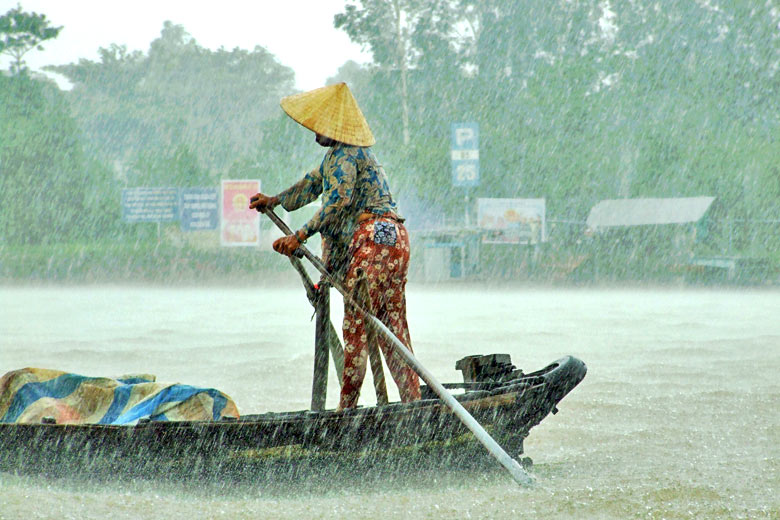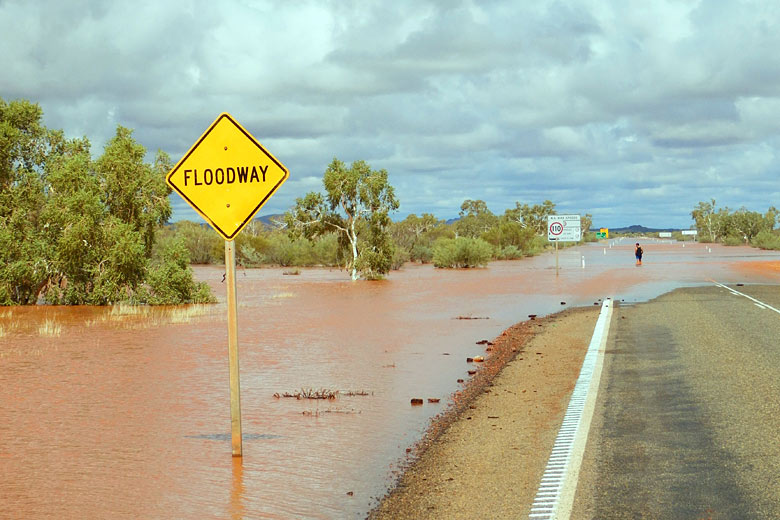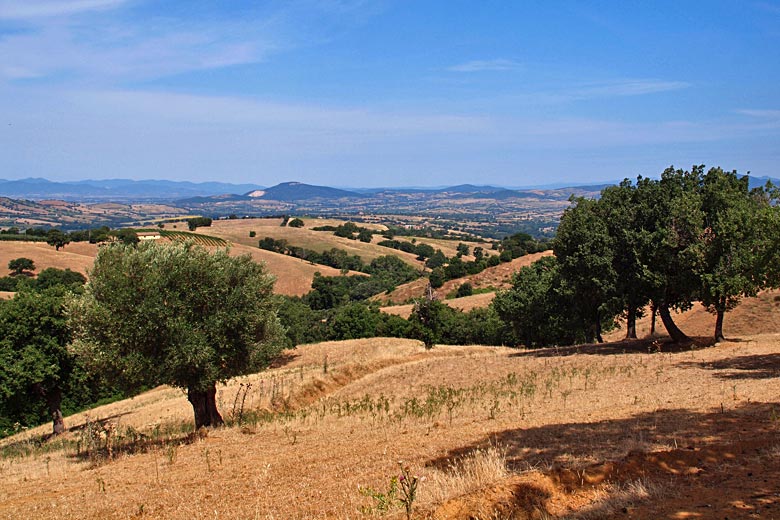Monthly rainfall averages
If you're looking for a breakdown of our average rainfall figures, then you've come to the right place. Here, we explain a little about the figures we use and how you can best utilise them when it comes to planning your next sunny holiday.
We also examine how rain is formed and look at why using average rainfall figures in isolation can be misleading - on that note, don't forget to check out our complete weather parameter series, with even more information on everything from the average maximum temperature to daylight hours and sea temperature.

Average rainfall: what is rain?
Anyone living in the UK will feel confident that they know what rainfall is, having had extensive first hand experience, but do you know how rain is formed?
The simple answer is that rain occurs when water vapour in a cloud cools and condenses resulting in rain (or snow if the temperature is low enough). There are a number of ways in which clouds can quickly cool: it can happen when air is forced up the side of a mountain it can't go around.
This air rises and cools as it expands in the lower pressure - with the temperature dropping 5°C to 10°C every 1,000m - eventually to the point where the water vapour condenses.
As an example, the west of Scotland has many high mountains directly in the path of damp air blowing in off the Atlantic, which are largely responsible for the much higher rainfall in the west compared with the east; Fort William has three times the annual rainfall of Aberdeen.
Warm air and cooler air can also collide creating the same result. This happens when two air masses meet along a line called a weather front, something you will often hear mentioned in weather forecasts.
When two air masses of different pressure collide, they won't simply merge into each other; warmer air will always rise over the cooler air - as if it was an invisible mountain - with the same result as described above; and rain generally occurs behind the front.
Rainfall can also occur when the warming action of the sun heats the earth or the sea enough for the air above it to rise and expand to the point where clouds form and rise further until they cool enough for rain to fall.
This process is called 'convective rainfall' and is a common cause of afternoon showers throughout the tropics.
The amount of water vapour that a cloud can contain - and therefore the amount of rain that will fall - depends on the air temperature: the higher the temperature, the more water vapour.
This is one reason why it tends to rain more heavily in the tropics, and why cooler destinations like the UK often get a lot of drizzle.
How variable is rainfall?
Unlike some other weather parameters, such as temperature, rainfall is much more variable, which can have a significant ripple effect from either too much or too little rain.
For example, in the UK, if there's a cold or hot summer it is usually only varies by a few degrees.
However, if there's a wet or dry summer, rainfall can sometimes be more than double the average or way below, which makes a huge difference not only to our daily lives but to everything from farming to wildlife.
In some regions of the world, fluctuations in global weather patterns play a role in this respect, the best known being El Nino in the Pacific Ocean.
During an El Nino event, which happens every two to seven years, parts of Peru and Ecuador experience much higher than average rainfall for a year or so while at the same time drought conditions prevail in parts of Australia.

In regions of the world which are naturally very dry, such as in a desert, years can pass with no rain at all. However, on occasion, a desert may also experience many times the average rainfall, sometimes in a matter of hours, which can cause widespread flash flooding.
Why is average rainfall important to holidaymakers?
The figures we show for rainfall are the amounts of rain that normally fall during each month, based on 30 years of daily weather observations.
But these figures don't tell you as much as you might think because the absence of rain does not necessarily mean fine sunny weather, nor does an abundance of it indicate that you are going to have a miserable time.
For example, in Lima, Peru during August there is hardly a drop of rain but there's also very little sunshine. While in Orlando in August, there's both high levels of rainfall and long periods of sunshine. Again, Rome has 30% more rain throughout the year than London, but 60% more sunshine.
So, if you need to assess what role rainfall might play in your holiday you need to look at other weather parameters as well, such as the amount of sunshine your destination gets in the month, and the number days in the month when some rainfall is recorded.
Looking at two of the examples above, Lima has 3mm of rain normally during August and two days in the month when some rainfall is recorded but there is only one hour of sunshine a day on average.
This is largely down to the cold Humboldt current which sweeps in from the Southern Ocean bringing some of the greyest winter weather experienced anywhere. In fact, most of August in Lima is spent in fog.
Orlando in Florida on the other hand usually gets 171mm of rain in August (that's a whole summer's worth by UK standards) falling over 16 days, but there are still normally nine hours of sunshine a day, which is very sunny. So, do look too at the sunshine figures.
While rainfall figures aren't that useful on their own, they do provide some information at a glance by showing you whether or not there is a dry season, and how long it lasts. A quick look at the rainfall figures for each destination will show how evenly rainfall is spread through the year.
In the tropics, dry seasons occur during the 'low sun' or 'winter' season, when the heat of the sun is insufficient to produce convective rainfall (described above).
Monthly rainfall typically dips to 50mm or less, and this can be seen in the figures all across the Caribbean from Christmas onwards - an ideal time to travel there because, unlike in Peru, it is also sunny at this time of year.
Other classic Northern Hemisphere winter dry season regions are India, Thailand, Burma, and Vietnam while Bali in Indonesia offers similar 'low sun' weather conditions between June and September, during Bali's Southern Hemisphere winter.

Dry seasons also occur closer to home, notably in the Mediterranean during the summer months when rainfall is almost totally absent for months on end, more commonly in the eastern Med.
The cause of the dry season in the Mediterranean in summer is the dominance of high pressure at this time of year. High pressure systems always contain dry air so there is little in the way of cloud, let alone rain.
Majorca usually gets less than 150mm of rain in the five months from the beginning of May to the end of September, while most islands in the Aegean see less than 50mm over the same period.
However, even the 150mm of rain Majorca sees from May to September is hopelessly inadequate to prevent drought setting in.
The sun is so strong that it evaporates practically all the moisture from the ground and the vegetation, and the landscape becomes parched. Once summer is over the rains return.
The figures, therefore, should give you some indication of what the landscape will be like; heading to Sicily at the end of the dry summer season? Expect arid conditions, while visit in the spring and it is surprisingly green.

Then there are those places where a dry season is almost permanent; Dubai, for example, receives less than 100mm in rainfall during a whole year, 99% of it in the winter months, so little that there is barely any natural vegetation.
The key to making the most of our rainfall figures is to use them as a guide as part of your holiday research in conjunction with other parameters especially sunshine.
It's also definitely worth using our weather comparison tool, not to mention reading more about the other weather parameters such as days with rain (yes, this is something different), UV risks, daylight hours, tropical storm risk, and more.
Once you've found your ideal destination, head over to our travel deals and discounts section for the latest online offers from leading holiday companies, airlines, and more.
More holiday weather parameters:
- Daylight hours
- Days with some rainfall
- Heat and humidity levels
- Maximum daytime temperature
- Minimum night-time temperature
- Sea temperature
- Sunshine hours
- UV index (maximum)
Monthly rainfall by month
Below is the monthly rainfall levels for popular holiday destinations around the world by month. Select a month to see top destinations or search by name to see all months.
Monthly rainfall in January
- Bali
- Cyprus
- Maldives
- Jamaica
- Malta
- Costa del Sol
- Dominican Republic
- Tenerife
- Majorca
- Barbados
- Phuket, Thailand
- Ibiza
- Benidorm
- Cape Town
- Kenyan Coast
- Gran Canaria
- Lanzarote
- Fuerteventura
- Dubai
- Chiang Mai, Thailand
- Kerala
- Sharm el Sheikh
- Goa
Monthly rainfall in February
- Bali
- Cyprus
- Costa del Sol
- Sri Lanka
- Jamaica
- Maldives
- Dominican Republic
- Malta
- Tenerife
- Majorca
- Barbados
- Dubai
- Benidorm
- Cape Town
- Ibiza
- Gran Canaria
- Phuket, Thailand
- Kerala
- Lanzarote
- Fuerteventura
- Kenyan Coast
- Chiang Mai, Thailand
- Sharm el Sheikh
- Goa
- Luxor, Egypt
Monthly rainfall in March
- Bali
- Sri Lanka
- Orlando
- Maldives
- Costa del Sol
- Kenyan Coast
- Cyprus
- Majorca
- Algarve
- Dominican Republic
- Miami
- Tenerife
- Ibiza
- Barbados
- Malta
- Cancun
- Benidorm
- Morocco
- Jamaica
- Dubai
- Gran Canaria
- Lanzarote
- Fuerteventura
- Sharm el Sheikh
- Luxor, Egypt
Monthly rainfall in April
- Seychelles
- Mauritius
- Bali
- Dominican Republic
- Miami
- Orlando
- Majorca
- Jamaica
- Costa del Sol
- Barbados
- Cancun
- Algarve
- Ibiza
- Benidorm
- Tenerife
- California
- Morocco
- Cyprus
- Malta
- Gran Canaria
- Dubai
- Lanzarote
- Sharm el Sheikh
Monthly rainfall in May
- Miami
- Cancun
- Bali
- Mauritius
- Orlando
- Rome
- Majorca
- Benidorm
- Costa del Sol
- Algarve
- Antalya
- Marmaris
- Ibiza
- Bodrum
- Crete
- Rhodes
- Tunisia
- Morocco
- Santorini
- Cyprus
- Tenerife
- Malta
- Lanzarote
- Sharm el Sheikh
- Dubai
Monthly rainfall in June
- Orlando
- Bali
- Nice
- Barcelona
- Rome
- Naples
- Benidorm
- Corfu
- Majorca
- Costa del Sol
- Marmaris
- Algarve
- Ibiza
- Bodrum
- Antalya
- Crete
- Tunisia
- Rhodes
- Tenerife
- Cyprus
- Santorini
- Malta
- Gran Canaria
- Dubai
- Fuerteventura
- Lanzarote
- Sharm el Sheikh
Monthly rainfall in July
- Orlando
- Lake District
- Western Australia
- Maldives
- French Alps
- Slovenia
- Bali
- Yorkshire Dales
- Dolomites
- Italian Alps
- Switzerland
- Krakow
- Bosnia and Herzegovina
- Faroe Islands
- Norway
- Pyrenees
- Latvia
- Lithuania
- Estonia
- Belgium
- Boston
- Peak District
- Poland
- Amsterdam
- Italian Lakes
- Netherlands
- Blackpool
- Denmark
- Toronto
- Austria
- Milan
- Vienna
- Finland
- Alberta
- Iceland
- Wales
- Sweden
- Venetian Riviera
- Northern Ireland
- Scotland
- Cornwall
- Northumberland
- Devon
- Hungary
- Paris
- Cotswolds
- Somerset
- Suffolk
- Dubrovnik
- Ireland
- Dordogne
- Zanzibar
- Brittany
- Loire Valley
- London
- British Columbia
- Croatia
- Montenegro
- Normandy
- North Macedonia
- Channel Islands
- Dorset
- Sunny Beach
- Albania
- Florence
- Italian Riviera
- Tuscany
- Bulgaria
- Azores, Portugal
- Costa Brava
- Puglia
- Barcelona
- Campania
- Naples
- South of France
- Calabria
- Costa Dorada
- Provence
- Hawaii
- Corsica
- Corfu
- Benidorm
- Costa Blanca
- Madeira
- Majorca
- Ibiza
- Menorca
- Sardinia
- Sicily
- Costa Almeria
- Costa del Sol
- Mykonos
- Antalya
- Crete
- Cyprus
- Tunisia
- Algarve
- California
- Rhodes
- Santorini
- Tenerife
- Dubai
- Egypt's Red Sea
- Gran Canaria
- Lanzarote
- Malta
Monthly rainfall in August
- Lake District
- Orlando
- Yorkshire Dales
- Slovenia
- Switzerland
- Pyrenees
- Italian Alps
- New York
- Faroe Islands
- Peak District
- Northern Ireland
- Iceland
- Latvia
- Bosnia and Herzegovina
- Sarajevo
- Cornwall
- Lithuania
- Ireland
- Pembrokeshire
- Amsterdam
- Devon
- Edinburgh
- Netherlands
- Scotland
- Northumberland
- Montenegro
- Croatia
- Belgium
- Germany
- Denmark
- Austria
- Poland
- Tuscany
- East Sussex
- Isle of Wight
- Dorset
- Kent
- Norfolk
- Somerset
- Suffolk
- Bali
- Cambridge
- Channel Islands
- Northern France
- Vancouver
- Budapest
- Hungary
- Alberta
- Costa Dorada
- Zanzibar
- Albania
- Nice
- North Macedonia
- Naples
- Bulgaria
- Ibiza
- Majorca
- Menorca
- Corfu
- Corsica
- Benidorm
- Sardinia
- Tunisia
- Costa del Sol
- Malta
- California
- Costa Almeria
- Los Angeles
- Tenerife
- Algarve
- Costa de la Luz
- Cyprus
- Rhodes
- Crete
- Santorini
- Dubai
- Gran Canaria
- Lanzarote
Monthly rainfall in September
- Lake District
- Yorkshire Dales
- Orlando
- Faroe Islands
- Slovenia
- Bali
- Montenegro
- Pyrenees
- Peak District
- Northern Ireland
- Iceland
- Cornwall
- Switzerland
- Albania
- Devon
- Pembrokeshire
- Bosnia and Herzegovina
- Italian Alps
- Channel Islands
- Netherlands
- Rome
- Corfu
- Naples
- Latvia
- Tuscany
- East Sussex
- Edinburgh
- Scotland
- Dorset
- Isle of Wight
- Kent
- Lithuania
- Nice
- Ireland
- Denmark
- Belgium
- Majorca
- Northern France
- Northumberland
- Norfolk
- Somerset
- Suffolk
- Cambridge
- North Macedonia
- Germany
- Ibiza
- Poland
- Austria
- Benidorm
- Malta
- Tunisia
- Johannesburg
- Madrid
- Lisbon
- Crete
- Bodrum
- Costa del Sol
- Marmaris
- Algarve
- Tenerife
- Antalya
- Rhodes
- Gran Canaria
- San Francisco
- Morocco
- Cyprus
- Lanzarote
- Dubai
Monthly rainfall in October
- Sri Lanka
- Lake District
- Kerala
- Maldives
- Seychelles
- Thailand
- Caribbean Coast, Mexico
- Yorkshire Dales
- Faroe Islands
- Barbados
- Bali
- Jamaica
- Montenegro
- Italian Riviera
- British Columbia
- Florida
- Dominican Republic
- Goa
- Pyrenees
- Iceland
- Calabria
- Slovenia
- Albania
- Peak District
- South of France
- Cornwall
- Northern Ireland
- Brittany
- Pembrokeshire
- Devon
- Majorca
- Zanzibar
- Crete
- Channel Islands
- East Sussex
- Kenyan Coast
- Gambia
- Malta
- Italian Lakes
- Provence
- Bosnia and Herzegovina
- Dorset
- Madeira
- Netherlands
- Isle of Wight
- Kent
- Marmaris
- Benidorm
- Costa Blanca
- Dordogne
- Antalya
- Edinburgh
- Scotland
- Belgium
- Ibiza
- Normandy
- Rhodes
- Ireland
- Dolomites
- Italian Alps
- Northumberland
- Latvia
- Kos
- Northern France
- Costa del Sol
- Loire Valley
- Denmark
- Norfolk
- Somerset
- Suffolk
- Switzerland
- Tunisia
- Bodrum
- Western Australia
- Lithuania
- North Macedonia
- Mauritius
- Sunny Beach
- Cambridge
- Hawaii
- Mykonos
- Tenerife
- Hungary
- Austria
- Germany
- Poland
- Cyprus
- Morocco
- Alberta
- Gran Canaria
- Cape Verde
- California
- Lanzarote
- Sharm el Sheikh
- Luxor
- Dubai
- Oman
Monthly rainfall in November
- Lake District
- Sri Lanka
- Montenegro
- Seychelles
- Zanzibar
- British Columbia
- Yorkshire Dales
- Maldives
- Bali
- Barbados
- Albania
- Faroe Islands
- Italian Riviera
- Kerala
- Pyrenees
- Slovenia
- Antalya
- Brittany
- Dominican Republic
- Cornwall
- Peak District
- Channel Islands
- Jersey
- Jamaica
- Madeira
- Devon
- Calabria
- Pembrokeshire
- South of France
- Corsica
- Rhodes
- East Sussex
- Bosnia and Herzegovina
- Costa del Sol
- Iceland
- Kenyan Coast
- Northern Ireland
- Italian Lakes
- Caribbean Coast, Mexico
- Kos
- Dordogne
- Kent
- Netherlands
- Isle of Wight
- Normandy
- Dorset
- Switzerland
- Majorca
- Menorca
- Belgium
- Florida
- Miami
- Cuba
- Malta
- Provence
- Edinburgh
- Scotland
- Tenerife
- North Macedonia
- Mauritius
- Mykonos
- Dolomites
- Ireland
- Italian Alps
- Loire Valley
- Norfolk
- Northumberland
- Somerset
- Suffolk
- Sunny Beach
- Denmark
- Hawaii
- Latvia
- Northern France
- Lithuania
- Hungary
- Benidorm
- Costa Blanca
- Cyprus
- Ibiza
- California
- Cambridge
- Germany
- Thailand
- Austria
- Poland
- Morocco
- Tunisia
- Goa
- Gran Canaria
- Western Australia
- Lanzarote
- Alberta
- Fuerteventura
- Gambia
- Oman
- Cape Verde
- Marsa Alam
- Dubai
- Egypt's Red Sea
- Sharm el Sheikh
- Luxor
- Luxor, Egypt
Monthly rainfall in December
- Lake District
- Fort William
- Tahiti
- Singapore
- Seychelles
- Bali
- Antalya Coast
- Dalaman & Marmaris
- Kuala Lumpur
- Santiago de Compostela
- British Columbia
- Vancouver
- Fiji
- Montenegro
- Yorkshire Dales
- Corfu
- Rio de Janeiro
- Zambia
- Maldives
- Zante
- Kefalonia
- Zanzibar
- Faroe Islands
- Porto
- Rhodes
- Tobago
- Sri Lanka
- Bodrum & Izmir
- Kos
- Mauritius
- Bermuda
- St Lucia
- Peloponnese
- Albania
- Grenada
- Brittany
- San Sebastian
- Brisbane
- French Alps
- Galapagos
- Bilbao
- New Orleans
- Croatia
- Istanbul
- Gibraltar
- Azores
- Peak District
- Cornwall
- Crete
- Devon
- Machu Picchu
- British Virgin Islands
- Andorra
- Pyrenees
- Calabria
- Johannesburg
- Campania
- Jersey
- Naples
- Wales
- Madeira
- Cyprus
- Lisbon
- Boston
- Jamaica
- Pembrokeshire
- Mykonos
- Santorini
- Sorrento
- Blackpool
- Bristol
- Costa de la Luz
- Guernsey
- Iceland
- Algarve
- Malta
- Turks & Caicos
- Rome
- San Francisco
- Skiathos
- Barbados
- Bath
- Curacao
- Montreal
- Philippines
- Slovenia
- Italian Riviera
- Luxembourg
- Dordogne
- New York City
- New Zealand
- Northern Ireland
- Argentina
- Bosnia & Herzegovina
- Dorset
- Sardinia
- Seville
- Costa del Sol
- Dominican Republic
- La Palma
- St Kitts & Nevis
- Antigua
- Sicily
- Halkidiki
- Sydney
- Cancun & Riviera Maya
- Inverness
- Isle of Wight
- Botswana
- D.C.
- Hawaii
- Aruba
- Corsica
- Amsterdam
- Athens
- Netherlands
- Cotswolds
- Majorca
- Menorca
- Nice
- South of France
- Florence
- Tuscany
- Belgium
- Ireland
- Tenerife
- Kent
- Toronto
- Cologne
- Normandy
- Switzerland
- Venice
- Hamburg
- Marseille
- Provence
- St Andrews
- Jordan
- Lille
- Puglia
- Milan
- Edinburgh
- Kenyan Coast
- Scotland
- Chicago
- Loire Valley
- Costa Brava
- Granada
- Bulgaria
- North Macedonia
- Norway
- Sunny Beach
- Copenhagen
- Denmark
- London
- Norfolk
- Somerset
- Suffolk
- Estonia
- Finland
- Ibiza
- Northumberland
- Thessaloniki
- Melbourne
- Cuba
- Paris
- Berlin
- Lithuania
- Los Angeles
- Texas
- Verona
- Agadir
- Orlando
- Barcelona
- Cambridge
- Italian Lakes
- Latvia
- Madrid
- Benidorm
- Bucharest
- Costa Blanca
- Bahamas
- Hungary
- Japan
- Sweden
- Tunisia
- Cape Town
- Florida
- Miami
- Costa Dorada
- Kerala
- Valencia
- Krakow
- Costa Almeria
- Shanghai
- Austria
- Costa Rica
- Poland
- Marrakech
- Namibia
- Gran Canaria
- Dolomites
- Italian Alps
- Hong Kong
- Adelaide
- Cambodia
- Lanzarote
- Prague
- Puerto Vallarta
- Seoul
- Vietnam
- Fuerteventura
- Nepal
- Alberta
- Calgary
- Dubai
- Goa
- Perth
- Thailand
- Oman
- New Delhi
- Cape Verde
- Las Vegas
- Abu Dhabi
- Agra
- Cairo
- Red Sea, Egypt
- Jaipur
- Mumbai
- Beijing
- Chile
- Marsa Alam
- Gambia
- Senegal
- Luxor
Be inspired
Get your weekly fix of holiday inspiration from some of the world's best travel writers plus save on your next trip with the latest exclusive offers
We promise not to share your details
Related posts
Popular travel offers
Explore holiday destinations
- Beach holidays
- City breaks
- Family holidays
- Half term holidays
- Spring holidays
- Summer holidays
- Autumn holidays
- Winter sun holidays
- Honeymoons
- Coolcations
- Compare places
- Ski resorts
Save with latest deals & discounts
- Holiday offers
- Top travel brands
- Airlines & flights
- Discount hotels
- TUI
- Jet2holidays
- Neilson
- Marella Cruises
- Pierre & Vacances
- Caledonian Travel
- Club Med
- Boxing Day sales
Airport parking
- Manchester Airport
- Stansted Airport
- Bristol Airport
- Luton Airport
- Birmingham Airport
- Edinburgh Airport
- Gatwick Airport
- Glasgow Airport
- Newcastle Airport
Airport lounges
- Manchester Airport
- Birmingham Airport
- Bristol Airport
- Edinburgh Airport
- Glasgow Airport
- Heathrow Airport
- Newcastle Airport
- Stansted Airport
- Gatwick Airport























